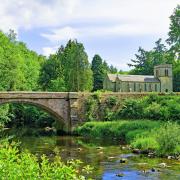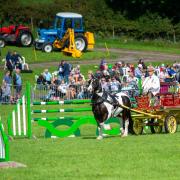Take a deep breath, but it could be time to let go. That pristine lawn you covet, as smooth as a snooker table and as soft as carpet is just not cutting it when it comes to helping to conserve one of our most beloved winged insects.
The good news is that a little goes a long way, and leaving even part of a garden to grow long grass can increase butterfly numbers by up to 93 per cent. Not only that but butterflies are good for our health – or at least counting them can be.
Scientific research by the wildlife charity, Butterfly Conservation, in collaboration with the University of Derby reveals that anxiety can be reduced and mental wellbeing improved by trying to keep tabs on the flying beauties.

It is an incentive to take part in the national Big Butterfly Count, whose participants in 2022 were surveyed for the pioneering investigation into the impact of the project. The results demonstrated that briefly tuning into nature to count butterflies reduced anxiety by nine per cent on average, while also enhancing people’s mental wellbeing.
Dr Richard Fox, head of science at Butterfly Conservation, says: “While we have long known that there is a link between nature and human wellbeing, this study is the first to prove that the simple act of looking for and counting butterflies leads to a measurable decrease in anxiety.”
Researchers found that spending just 15 minutes observing and counting butterflies boosted participants' feeling of connectedness with nature.
Experts believe that feeling more connected to nature correlates directly to how motivated people feel towards protecting it. Therefore, citizen science projects such as the Big Butterfly Count can play a vital role in nature’s recovery by not only informing conservation work through data collection but also encouraging people to act upon their interest in nature.

Dr Carly Butler, a researcher in ‘nature connectedness’ at the University of Derby and lead researcher on the study, adds: "Our study showed that even small periods of time spent watching and counting butterflies are beneficial, with the benefits of reduced anxiety and stronger nature connectedness being the same whether people carried out just one 15-minute count or took part multiple times.
“This is key in proving that simple, small pockets of time connecting with wildlife and nature have a profound and beneficial effect on how we feel.”
Participants reported a range of positive emotions such as joy and fascination, but also sadness and concern driven by not seeing as many butterflies as they expected and fear over what is happening to the planet.
Carly adds: “Interestingly, the more intensely participants felt these emotions, the more their feeling of closeness to nature and noticing wildlife increased afterwards, with participants reporting they felt motivated to help butterflies and nature more by doing things such as transforming their gardens into butterfly-friendly havens.”

Dr Fox adds: “In order to save wildlife and ensure nature’s recovery we need people to care, and we know that being connected to nature sparks these caring feelings and a desire to do something positive.
“We’re at a tipping point, nature is in crisis, but we can all do something to help. Simple acts such as creating wild spaces to provide a haven for wildlife, or planting butterfly friendly plants in pots on a patio, terrace or balcony can have a positive impact.”
Creating the environment for butterflies to thrive will go a long way towards upping the count. Recent evidence suggests that participants may spot more, at least of some species.

The latest results from the annual UK Butterfly Monitoring Scheme (UKBMS), led by Butterfly Conservation, the UK Centre for Ecology & Hydrology (UKCEH), British Trust for Ornithology (BTO) and the Joint Nature Conservation Committee (JNCC), show that some species soared last year.
Half the 58 species had a better than average year while the other half were below average at monitored sites. Species that flourished included Chequered Skipper, Brimstone and Large Blue, which all recorded their best year since the UKBMS began in 1976.
The Large Blue, which was reintroduced to the UK after becoming extinct in the 1970s, recorded its best year yet, showing the conservation work with this species is working.
Another species recording its best-ever year was the Red Admiral, a migratory species that has begun to overwinter in the UK as the climate has warmed, making it a common visitor across all habitats, including gardens. Its numbers have increased by 318 per cent at monitored sites since 1976.

Other species registering a remarkable year included Brown Argus, Marbled White, Comma, Black Hairstreak and Holly Blue, which all ranked in their top three best years since recording began.
Other species, however, continued worrying declines. The Small Pearl-bordered Fritillary and garden favourite and another species found in Cumbria, the Small Tortoiseshell, recorded their lowest numbers in the 48 years of monitoring, declining by 71 per cent and 82 per cent, respectively.
Cryptic Wood White, Grizzled Skipper, Pearl-bordered Fritillary, Grayling and Scotch Argus faced significant difficulties, and the Green-veined White and Ringlet both had a poor year.

Dr Fox explains: “Butterfly numbers fluctuate naturally from year to year, largely due to the weather, but the long-term trends of UK butterflies are mainly driven by human activity, including habitat damage and destruction, pesticide use, pollution and climate change. By monitoring long-term butterfly trends we can learn about the impact of climate change and other factors on our native wildlife.”
Dr Marc Botham, butterfly ecologist at the UK Centre for Ecology and Hydrology, adds: “Butterflies are an indicator species, meaning they can tell us about the health of the wider environment, which makes the UKBMS data invaluable in assessing the health of our countryside and natural world in general. The mixed results this year emphasise the need for continued monitoring and conservation efforts to protect these important species and their habitats.”
Back in the garden, wildlife-friendly practices, such as having long grass and flowering ivy, can help to boost the abundance and diversity of butterflies.
In another study, published in the journal Science of the Total Environment, Butterfly Conservation scientists Dr Fox together with Dr Lisbeth Hordley analysed butterfly sightings from more than 600 gardens across the UK over six years. The results show that gardens with long grass had a significantly higher number of butterflies recorded, with a greater variety of species, than those without.
In areas of intensive arable farmland, gardens with long grass saw up to 93 per cent more butterflies and those in urban areas showed an increase of 18 per cent.
Conservationists say that if every patch from the 728,000 hectares of garden that cover Great Britain kept some space a little wild, with grass growing long, it would make a huge difference for butterflies and moths, providing spaces for them to feed, breed and shelter.
The study also found that the presence of flowering ivy in gardens increased the number of certain butterfly species such as the Holly Blue and Red Admiral, which are both found in Cumbria and use ivy as a breeding habitat or nectar source.

The benefits to butterflies of long grass and wild spaces are likely to extend beyond the garden gate too. Public green spaces such as parks, school grounds, allotments and road verges could also provide vital spaces for wildlife and enable more people to see more butterflies if allowed to go a little wild.
Dr Fox adds: “Nature is in crisis; 80 per cent of butterflies have declined since the 1970s, so we need to take action now to protect them. We wanted to be able to give tried and tested gardening advice that will benefit butterflies as we know lots of people want to help.
“The simple act of creating wild spaces by allowing a patch of grass to grow long, or a border edge to go wild, is free and easy to do and can significantly boost butterfly numbers, especially in urban and agricultural settings where they are most under pressure. The benefits of each individual wild space are small, but if thousands of people get involved the boost to butterflies could be huge.”
The Big Butterfly Count is Butterfly Conservation’s flagship citizen science activity, involving tens of thousands of participants across the UK spending 15 minutes in any sunny spot and recording the number and type of common butterflies and day-flying moths they see. This year’s Big Butterfly Count takes place from Friday, July 12-Sunday, August 4.




























